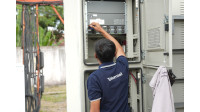Opinion
The Must-Know SaaS Trends for Southeast Asia&rsquos Business Leaders in 2023
06:19:55 | 12 Jan 2023

Accelerated digitalisation has redefined many aspects of social and economic life, and in particular, cloud-based software has been a driving force in Southeast Asia's continued productivity and resilience.
According to IDC, there is greater focus on increasing revenue via digital products and services, forecasting that one in three Southeast Asian businesses will generate more than 15% of their revenue from digital products and services in 2023, compared to one in six in 2020.
However, while it may be easier than ever for companies to buy software, that doesn't guarantee success for providers. Rather, driving businesses to more efficient and effective operating models hinges on keeping track of where their pain points lie. Here are six B2B SaaS trends to keep an eye out for, as organisations across the region strive to compete with global peers:
1. Demand for collaboration tools will persist as hybrid work takes off
In the Asia-Pacific (APAC) region, the demand for collaboration tools is likely to persist as the hybrid work model gains popularity, with a Telstra study finding 85% of organisations surveyed are promoting hybrid work arrangements. Gartner predicts that the "hybrid-flexible" work model, which combines location flexibility with online collaboration tools, will be successful in the region if implemented and managed properly. As companies in the region adapt to the post-COVID era, they will look for collaboration tools and collaboration inside existing tools that facilitate both synchronous and asynchronous communication, and allow employees to easily switch between different communication forms. Even companies that return to full on-site work are expected to continue using online productivity tools, having seen their benefits during the pandemic.
In addition to facilitating communication and collaboration, collaboration tools are also expected to play a key role in improving employee experience in the APAC region. As businesses in the region increasingly focus on improving the employee experience, they will look for collaboration tools that can help boost engagement, productivity, and overall satisfaction among their employees. As a result, the demand for collaboration tools is likely to continue to grow in the APAC region in the coming years.
2. Interoperability will gain over integration
In the region, the next wave of consolidation in the software-as-a-service (SaaS) landscape is expected to be focused on interoperability rather than integration. As businesses in the region look to invest in unified cloud platforms that support interoperable services, platforms that enable companies to choose the services they need for their operations and deploy them quickly and easily from a single console will likely see increased traction. PaaS offerings that employ common data models will also be attractive to companies in the region looking to integrate AI programs into their digital operations and extract valuable business intelligence. In addition to the trend towards interoperability, the APAC SaaS market is also expected to continue to grow rapidly in the coming years. As more businesses in the region adopt SaaS solutions, the demand for these services is likely to increase, driving further consolidation in the market. Furthermore, the proliferation of low-code/no-code platforms in the region is expected to make it easier for businesses to customise their SaaS solutions to meet their unique needs, further driving adoption. Overall, the SaaS landscape in the APAC region is likely to continue to evolve and consolidate in the coming years. 3. Deep-tech capabilities as cloud services will earn increased adoption
In APAC, companies looking to advance their digital transformation agendas are expected to experiment with new technologies such as AI and blockchain as cloud-based solutions. Offered over the cloud, these technologies will become more widely accessible and easily deployable, making it easier for businesses in the region to adopt and integrate them into their operations. A significant amount of research and development in areas such as machine learning, computer vision, and natural language processing is expected to improve the customer and employee experiences offered by modern SaaS applications. In addition to improving the customer and employee experiences, these technologies are also expected to help businesses in the APAC region equip their sales teams with powerful sales enablers, such as trend anomaly detection, productivity recommendations, and predictive analytics. As a result, the adoption of AI and blockchain in the cloud is likely to continue to grow in the APAC region in the coming years. Overall, the increasing use of these technologies is expected to drive the development of more advanced and sophisticated SaaS solutions in the region. 4. Extensive localisation as a means to win in diverse markets
New B2B markets for SaaS will continue to emerge as businesses across Southeast Asia tweak and fine-tune their cloud strategies. SaaS vendors will need to adapt their offerings to fit the diverse expectations of each market across Southeast Asia. Product or service localisation, aside from regional language support, should also include adaptation in terms of product design and navigation, ease of use, GTM strategies, service delivery, after-sales training and implementation support, and more.
5. Data privacy and security
Every B2B SaaS vendor sits on two different but equally valuable data piles—one involving confidential info about its customer organisations and another belonging to the customers of the customer organisations. In South-East Asia, legislation is coming into force in almost every country to protect both business and individual personal data. As such, SaaS vendors will need to invest more in an array of data security and privacy areas such as data center security, regulatory compliance, DevOps security, internal communications, privileged access control, and privacy-enhancing technologies. Additionally, vendors who can boldly make a public declaration that no customer data will ever be monetised to serve their own revenue needs will rise in brand value and trustworthiness in the eyes of the end user. Whether it’s a small business or a multinational corporation, the competition to digitise is more intense than ever. Amid this, there is no space for unnecessary complexity, especially if it hinders rather than facilitates business. While the B2B SaaS space continues to grow, vendors and providers have two options; deliver maximum value to users to increase retention rates and reduce churn, or fall by the wayside. Doing so will require the ability to meet customers where they are at, especially in a region like Southeast Asia, where robust competition is the name of the game. Written by :
Gibu Mathew, VP and GM APAC, Zoho Corp
1. Demand for collaboration tools will persist as hybrid work takes off
In the Asia-Pacific (APAC) region, the demand for collaboration tools is likely to persist as the hybrid work model gains popularity, with a Telstra study finding 85% of organisations surveyed are promoting hybrid work arrangements. Gartner predicts that the "hybrid-flexible" work model, which combines location flexibility with online collaboration tools, will be successful in the region if implemented and managed properly. As companies in the region adapt to the post-COVID era, they will look for collaboration tools and collaboration inside existing tools that facilitate both synchronous and asynchronous communication, and allow employees to easily switch between different communication forms. Even companies that return to full on-site work are expected to continue using online productivity tools, having seen their benefits during the pandemic.
Baca juga :
•
•
•
In the region, the next wave of consolidation in the software-as-a-service (SaaS) landscape is expected to be focused on interoperability rather than integration. As businesses in the region look to invest in unified cloud platforms that support interoperable services, platforms that enable companies to choose the services they need for their operations and deploy them quickly and easily from a single console will likely see increased traction. PaaS offerings that employ common data models will also be attractive to companies in the region looking to integrate AI programs into their digital operations and extract valuable business intelligence. In addition to the trend towards interoperability, the APAC SaaS market is also expected to continue to grow rapidly in the coming years. As more businesses in the region adopt SaaS solutions, the demand for these services is likely to increase, driving further consolidation in the market. Furthermore, the proliferation of low-code/no-code platforms in the region is expected to make it easier for businesses to customise their SaaS solutions to meet their unique needs, further driving adoption. Overall, the SaaS landscape in the APAC region is likely to continue to evolve and consolidate in the coming years. 3. Deep-tech capabilities as cloud services will earn increased adoption
In APAC, companies looking to advance their digital transformation agendas are expected to experiment with new technologies such as AI and blockchain as cloud-based solutions. Offered over the cloud, these technologies will become more widely accessible and easily deployable, making it easier for businesses in the region to adopt and integrate them into their operations. A significant amount of research and development in areas such as machine learning, computer vision, and natural language processing is expected to improve the customer and employee experiences offered by modern SaaS applications. In addition to improving the customer and employee experiences, these technologies are also expected to help businesses in the APAC region equip their sales teams with powerful sales enablers, such as trend anomaly detection, productivity recommendations, and predictive analytics. As a result, the adoption of AI and blockchain in the cloud is likely to continue to grow in the APAC region in the coming years. Overall, the increasing use of these technologies is expected to drive the development of more advanced and sophisticated SaaS solutions in the region. 4. Extensive localisation as a means to win in diverse markets
New B2B markets for SaaS will continue to emerge as businesses across Southeast Asia tweak and fine-tune their cloud strategies. SaaS vendors will need to adapt their offerings to fit the diverse expectations of each market across Southeast Asia. Product or service localisation, aside from regional language support, should also include adaptation in terms of product design and navigation, ease of use, GTM strategies, service delivery, after-sales training and implementation support, and more.
Every B2B SaaS vendor sits on two different but equally valuable data piles—one involving confidential info about its customer organisations and another belonging to the customers of the customer organisations. In South-East Asia, legislation is coming into force in almost every country to protect both business and individual personal data. As such, SaaS vendors will need to invest more in an array of data security and privacy areas such as data center security, regulatory compliance, DevOps security, internal communications, privileged access control, and privacy-enhancing technologies. Additionally, vendors who can boldly make a public declaration that no customer data will ever be monetised to serve their own revenue needs will rise in brand value and trustworthiness in the eyes of the end user. Whether it’s a small business or a multinational corporation, the competition to digitise is more intense than ever. Amid this, there is no space for unnecessary complexity, especially if it hinders rather than facilitates business. While the B2B SaaS space continues to grow, vendors and providers have two options; deliver maximum value to users to increase retention rates and reduce churn, or fall by the wayside. Doing so will require the ability to meet customers where they are at, especially in a region like Southeast Asia, where robust competition is the name of the game. Written by :
Gibu Mathew, VP and GM APAC, Zoho Corp
Artikel Terkait
-
 Industry - 05:04:00 | 08 Jul 2025
Industry - 05:04:00 | 08 Jul 2025Opini & Kolom
Deeskalasi mendadak dalam ketegangan AS-Tiongkok mengejutkan pasar -
 Indepth - 14:08:36 | 24 Jun 2025
Indepth - 14:08:36 | 24 Jun 2025Kolom Opini
Bahaya terbesar AI adalah kesombongan manusia yang merasa sudah memahaminya terlalu dini -
Global News - 07:51:00 | 09 Jun 2025
Opini & Kolom
Loyalty fraud adalah ancaman nyata bagi lembaga keuangan dan bisnis di Indonesia -
 Global News - 07:19:00 | 20 May 2025
Global News - 07:19:00 | 20 May 2025Opini & Kolom
Virtualisasi ada di jantung pengembangan jaringan telekomunikasi yang ideal -
 Indepth - 06:01:35 | 22 Mar 2025
Indepth - 06:01:35 | 22 Mar 2025Kolom Opini
Pusat data merupakan tulang punggung interkoneksi bagi seluruh layanan digital modern
Rekomendasi
Berita Pilihan
More Stories
PR Newswire
























































